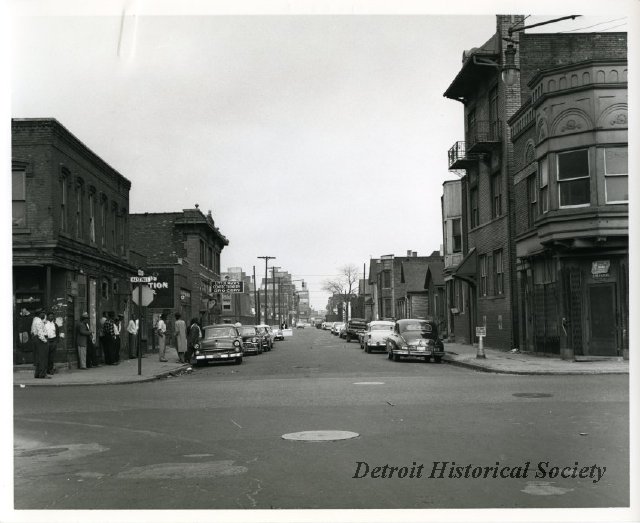Black Bottom was a predominantly Black neighborhood in Detroit, Michigan demolished for redevelopment in the late 1950s to early 1960s and replaced with the Lafayette Park residential district and a freeway. It was located on Detroit's near east side, bounded by Gratiot Avenue, Brush Street, the Detroit River, and the Grand Trunk railroad tracks.
An adjacent area that extended north of Gratiot, known as Paradise Valley was considered a different, though overlapping neighborhood, where most businesses and entertainment venues were located. Historically, the area of Black Bottom was part of the riverbed of the River Savoyard, which was buried as a sewer in 1827. The rich marsh soils of its bottom are the source of the area’s name.
Hastings Street, which ran north-south through Black Bottom, had been a center of Eastern European Jewish settlement well before World War I, with housing that was built in the late 19th, early 20th centuries. As the population began changing from immigrant to migrant, the wooden frame houses built side by side, some without indoor plumbing, became packed with African Americans from the South, come to work in the auto factories. Restrictive housing covenants prohibited them from living in most other parts of the city.
Black Bottom suffered more than most areas during the Great Depression, since many of the wage earners worked in the hard-hit auto factories. During World War II, both the economic activity and the physical decay of Black Bottom rapidly increased as many more people poured into a city faced with a housing shortage, and racial discrimination restricted Blacks to the increasingly overcrowded Black Bottom area.
Though by the 1950s, migration transformed Hastings and St. Antoine Streets into the city's major African-American community of black-owned businesses, social institutions and night clubs, nationally famous for its music scene in Paradise Valley. Hastings Street is also where Aretha Franklin's father, the Reverend C. L. Franklin, first opened his New Bethel Baptist Church. Businesses included ten restaurants, eight grocers, 17 physicians, and six drugstores, Barthwell Drugs being one of the well-known enterprises.
Although condemnation of property began in 1946, the National Housing Act of 1949, then later the 1956 National Highway Act, gave the city the funds to begin an urban renewal project in earnest, replacing Black Bottom and Paradise Valley with the Chrysler Freeway and Lafayette Park, a mixed-income development designed by Ludwig Mies van der Rohe. The east side neighborhood was gone by 1954 though Paradise Valley survived a few years more. Relocation assistance was minimal and many former Black Bottom and Paradise Valley residents were given 30 days notice to vacate. A number of the residents relocated to large public housing projects such as the Brewster-Douglass Housing Projects Homes and Jeffries Homes.

